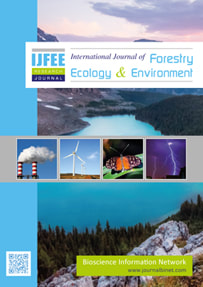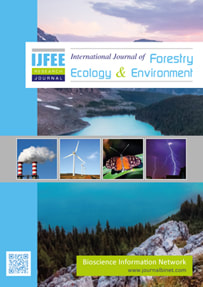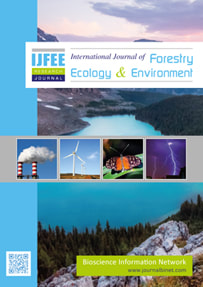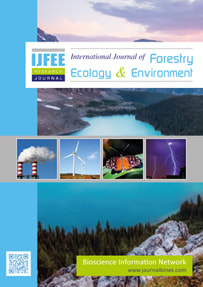International Journal of Forestry, Ecology & Environment
Volume 07 - Issue 01 | Year of Publication: 2023
Article Type: Research Article | No. 27, 2023 | Country: Tanzania | pp. 245-258 | Open Access
Title: Implementing institutional instruments for forest landscape protection in the Kilimanjaro world heritage site, Tanzania
Authors: Enoguanbhor, E. A., Enoguanbhor, E. C. and Albrecht, E.
DOI: https://doi.org/10.18801/ijfee.070123.27
Title: Implementing institutional instruments for forest landscape protection in the Kilimanjaro world heritage site, Tanzania
Authors: Enoguanbhor, E. A., Enoguanbhor, E. C. and Albrecht, E.
DOI: https://doi.org/10.18801/ijfee.070123.27
Implementing institutional instruments for forest landscape protection in the Kilimanjaro world heritage site, Tanzania
Abstract
Various institutional instruments, including World Heritage Convention (WHC) and other strategic policies, have been deployed to protect forest landscapes as natural heritage across the globe. Despite the implementation of these instruments to protect forest landscapes in World Heritage sites (WHS), the degradation problems persist, especially in the developing world, including Africa. Using the Kilimanjaro WHS in Tanzania as a case study, we investigated the state of implementing WHC and policies as strategic institutional instruments for forest landscape protection to support the sustainability of forests as a natural heritage. We collected empirical data using surveys of experts and integrated qualitative and quantitative (descriptive) analyses to investigate the implementation level of WHC and policies on forest protection, related the implementation level to primary forest degradation, and identified key challenges confronting the implementation. Key findings showed a low-level implementation of WHC and policies for forest protection. Also, our study showed that low-level implementation is associated with 19.83% of forest degradation from 1976 to 2020. Additionally, our study identified key challenges confronting all institutional instruments deployed for forest protection, including a lack of forest protection/conservation education in local communities, a low level of law enforcement on forest degradation, inadequate resources, wildfire, a lack of political will, political interference/interests, inadequate personnel, a lack of inter-departmental coordination, and conflicts with local communities. Our findings are of great importance for decision-makers to improve the implementation level of the WHC and policies as strategic institutional instruments and to improve the sustainability of forests as a natural heritage in Africa and other parts of the world.
Key Words: Institutional Instruments; Strategic Policies; Forest Protection; Forest Degradation; Forest Sustainability; Kilimanjaro and Africa
Abstract
Various institutional instruments, including World Heritage Convention (WHC) and other strategic policies, have been deployed to protect forest landscapes as natural heritage across the globe. Despite the implementation of these instruments to protect forest landscapes in World Heritage sites (WHS), the degradation problems persist, especially in the developing world, including Africa. Using the Kilimanjaro WHS in Tanzania as a case study, we investigated the state of implementing WHC and policies as strategic institutional instruments for forest landscape protection to support the sustainability of forests as a natural heritage. We collected empirical data using surveys of experts and integrated qualitative and quantitative (descriptive) analyses to investigate the implementation level of WHC and policies on forest protection, related the implementation level to primary forest degradation, and identified key challenges confronting the implementation. Key findings showed a low-level implementation of WHC and policies for forest protection. Also, our study showed that low-level implementation is associated with 19.83% of forest degradation from 1976 to 2020. Additionally, our study identified key challenges confronting all institutional instruments deployed for forest protection, including a lack of forest protection/conservation education in local communities, a low level of law enforcement on forest degradation, inadequate resources, wildfire, a lack of political will, political interference/interests, inadequate personnel, a lack of inter-departmental coordination, and conflicts with local communities. Our findings are of great importance for decision-makers to improve the implementation level of the WHC and policies as strategic institutional instruments and to improve the sustainability of forests as a natural heritage in Africa and other parts of the world.
Key Words: Institutional Instruments; Strategic Policies; Forest Protection; Forest Degradation; Forest Sustainability; Kilimanjaro and Africa
HOW TO CITE THIS ARTICLE?
MLA
Enoguanbhor, E. A. et al. “Implementing Institutional Instruments for Forest Landscape Protection in the Kilimanjaro World Heritage Site, Tanzania”. International Journal of Forestry, Ecology and Environment 07(01) (2023): 245-258.
APA
Enoguanbhor, E. A., Enoguanbhor, E. C. and Albrecht, E. (2023). Implementing Institutional Instruments for Forest Landscape Protection in the Kilimanjaro World Heritage Site, Tanzania. International Journal of Forestry, Ecology and Environment, 07(01), 245-258.
Chicago
Enoguanbhor, E. A., Enoguanbhor, E. C. and Albrecht, E. “Implementing Institutional Instruments for Forest Landscape Protection in the Kilimanjaro World Heritage Site, Tanzania”. International Journal of Forestry, Ecology and Environment 07(01) (2023): 245-258.
Harvard
Enoguanbhor, E. A., Enoguanbhor, E. C. and Albrecht, E. 2023. Implementing Institutional Instruments for Forest Landscape Protection in the Kilimanjaro World Heritage Site, Tanzania. International Journal of Forestry, Ecology and Environment, 07(01), pp. 245-258.
Vancouver
Enoguanbhor, EA, Enoguanbhor, EC and Albrecht, E. Implementing Institutional Instruments for Forest Landscape Protection in the Kilimanjaro World Heritage Site, Tanzania. International Journal of Forestry, Ecology and Environment. 2023 October, 07(01): 245-258.
MLA
Enoguanbhor, E. A. et al. “Implementing Institutional Instruments for Forest Landscape Protection in the Kilimanjaro World Heritage Site, Tanzania”. International Journal of Forestry, Ecology and Environment 07(01) (2023): 245-258.
APA
Enoguanbhor, E. A., Enoguanbhor, E. C. and Albrecht, E. (2023). Implementing Institutional Instruments for Forest Landscape Protection in the Kilimanjaro World Heritage Site, Tanzania. International Journal of Forestry, Ecology and Environment, 07(01), 245-258.
Chicago
Enoguanbhor, E. A., Enoguanbhor, E. C. and Albrecht, E. “Implementing Institutional Instruments for Forest Landscape Protection in the Kilimanjaro World Heritage Site, Tanzania”. International Journal of Forestry, Ecology and Environment 07(01) (2023): 245-258.
Harvard
Enoguanbhor, E. A., Enoguanbhor, E. C. and Albrecht, E. 2023. Implementing Institutional Instruments for Forest Landscape Protection in the Kilimanjaro World Heritage Site, Tanzania. International Journal of Forestry, Ecology and Environment, 07(01), pp. 245-258.
Vancouver
Enoguanbhor, EA, Enoguanbhor, EC and Albrecht, E. Implementing Institutional Instruments for Forest Landscape Protection in the Kilimanjaro World Heritage Site, Tanzania. International Journal of Forestry, Ecology and Environment. 2023 October, 07(01): 245-258.
Article Type: Research Article | No. 28, 2023 | Country: Kenya | pp. 259-269 | Open Access
Title: Integrating traditional, indigenous and local knowledge in forest conservation in Embobut Forest, Kenya
Authors: Kinyili, B. M. and Ndunda, E.
DOI: https://doi.org/10.18801/ijfee.070123.28
Title: Integrating traditional, indigenous and local knowledge in forest conservation in Embobut Forest, Kenya
Authors: Kinyili, B. M. and Ndunda, E.
DOI: https://doi.org/10.18801/ijfee.070123.28
Integrating traditional, indigenous and local knowledge in forest conservation in Embobut Forest, Kenya
Abstract
The prospect for traditional, indigenous and local ecological knowledge in contributing to conservation and management of forests and forest resources is well documented. However, the concrete application of knowledge in fostering forest conservation is rarely practiced. It is hypothesized that when traditional, indigenous and local knowledge is integrated into forest conservation, there is likely to be a success through the integration of several stakeholders. To date, there are several social, economic and policy challenges impeding the application of the knowledge in the local context. This study explored how traditional, indigenous and local knowledge can be fostered to help in forest conservation of Embobut forest. The study focused on indigenous knowledge of forest adjacent communities and dwellers belonging to four groups who inhabit the Embobut forest: Sengwers, Marakwets, Pokots and Luhyas. The study used a combination of qualitative methods and ethnographic study approaches. Data were collected from the respondents through semi-structured questionnaires, interviews, focus group discussions and key informant interviews. The study found a need for community elders to be encouraged to pass the indigenous knowledge to the youth through initiation ceremonies, word of mouth and cultural day’s celebrations. This indigenous knowledge needs to be documented and, published and integrated into forest management plans in the Embobut forest. Policy makers need to support patenting, copyrights, trade secrets and intellectual property rights of the essential indigenous knowledge with innovative ideas. For indigenous knowledge to be appreciated by younger generation, there is a need to revise and incorporate the content into the curriculum. They were additionally, integrating new scientific knowledge conspicuous with indigenous and traditional knowledge yielded a more remarkable outcome, fostering sustainable utilization and management of the local forest resources.
Key Words: Indigenous knowledge, Local knowledge, Biodiversity conservation and Embobut forest
Abstract
The prospect for traditional, indigenous and local ecological knowledge in contributing to conservation and management of forests and forest resources is well documented. However, the concrete application of knowledge in fostering forest conservation is rarely practiced. It is hypothesized that when traditional, indigenous and local knowledge is integrated into forest conservation, there is likely to be a success through the integration of several stakeholders. To date, there are several social, economic and policy challenges impeding the application of the knowledge in the local context. This study explored how traditional, indigenous and local knowledge can be fostered to help in forest conservation of Embobut forest. The study focused on indigenous knowledge of forest adjacent communities and dwellers belonging to four groups who inhabit the Embobut forest: Sengwers, Marakwets, Pokots and Luhyas. The study used a combination of qualitative methods and ethnographic study approaches. Data were collected from the respondents through semi-structured questionnaires, interviews, focus group discussions and key informant interviews. The study found a need for community elders to be encouraged to pass the indigenous knowledge to the youth through initiation ceremonies, word of mouth and cultural day’s celebrations. This indigenous knowledge needs to be documented and, published and integrated into forest management plans in the Embobut forest. Policy makers need to support patenting, copyrights, trade secrets and intellectual property rights of the essential indigenous knowledge with innovative ideas. For indigenous knowledge to be appreciated by younger generation, there is a need to revise and incorporate the content into the curriculum. They were additionally, integrating new scientific knowledge conspicuous with indigenous and traditional knowledge yielded a more remarkable outcome, fostering sustainable utilization and management of the local forest resources.
Key Words: Indigenous knowledge, Local knowledge, Biodiversity conservation and Embobut forest
HOW TO CITE THIS ARTICLE?
MLA
Kinyili, B. M. et al. “Integrating traditional, indigenous and local knowledge in forest conservation in Embobut Forest, Kenya”. International Journal of Forestry, Ecology and Environment 07(01) (2023): 259-269.
APA
Kinyili, B. M. and Ndunda, E. (2023). Integrating traditional, indigenous and local knowledge in forest conservation in Embobut Forest, Kenya. International Journal of Forestry, Ecology and Environment, 07(01), 259-269.
Chicago
Kinyili, B. M. and Ndunda, E. “Integrating traditional, indigenous and local knowledge in forest conservation in Embobut Forest, Kenya”. International Journal of Forestry, Ecology and Environment 07(01) (2023): 259-269.
Harvard
Kinyili, B. M. and Ndunda, E. 2023. Integrating traditional, indigenous and local knowledge in forest conservation in Embobut Forest, Kenya. International Journal of Forestry, Ecology and Environment, 07(01), pp. 259-269.
Vancouver
Kinyili, BM and Ndunda, E. Integrating traditional, indigenous and local knowledge in forest conservation in Embobut Forest, Kenya. International Journal of Forestry, Ecology and Environment. 2023 October, 07(01): 259-269.
MLA
Kinyili, B. M. et al. “Integrating traditional, indigenous and local knowledge in forest conservation in Embobut Forest, Kenya”. International Journal of Forestry, Ecology and Environment 07(01) (2023): 259-269.
APA
Kinyili, B. M. and Ndunda, E. (2023). Integrating traditional, indigenous and local knowledge in forest conservation in Embobut Forest, Kenya. International Journal of Forestry, Ecology and Environment, 07(01), 259-269.
Chicago
Kinyili, B. M. and Ndunda, E. “Integrating traditional, indigenous and local knowledge in forest conservation in Embobut Forest, Kenya”. International Journal of Forestry, Ecology and Environment 07(01) (2023): 259-269.
Harvard
Kinyili, B. M. and Ndunda, E. 2023. Integrating traditional, indigenous and local knowledge in forest conservation in Embobut Forest, Kenya. International Journal of Forestry, Ecology and Environment, 07(01), pp. 259-269.
Vancouver
Kinyili, BM and Ndunda, E. Integrating traditional, indigenous and local knowledge in forest conservation in Embobut Forest, Kenya. International Journal of Forestry, Ecology and Environment. 2023 October, 07(01): 259-269.
Article Type: Research Article | No. 29, 2023 | Country: Bangladesh | pp. 270-276 | Open Access
Title: Evaluation of antifungal activities of Xerophytes against plant pathogenic fungi considering their radial mycelial growth inhibition at different concentrations
Authors: Alim, S., Sultana, S. and Mondal, C.
DOI: https://doi.org/10.18801/ijfee.070123.29
Title: Evaluation of antifungal activities of Xerophytes against plant pathogenic fungi considering their radial mycelial growth inhibition at different concentrations
Authors: Alim, S., Sultana, S. and Mondal, C.
DOI: https://doi.org/10.18801/ijfee.070123.29
Evaluation of antifungal activities of Xerophytes against plant pathogenic fungi considering their radial mycelial growth inhibition at different concentrations
Abstract
Bangladesh is the land of many indigenous herbal medicinal plants. These plants have the potential for antimicrobial activities because of having a wide variety of secondary metabolites. Extracts of leaves of four selected xeric plants were taken to evaluate the antifungal activities against plant pathogenic organisms considering their radial mycelial growth inhibition at different concentrations. Extracts of the selected xerophyte plants (Vacuellia nilotica, Calotropis gigantea, Ziziphus mauritiana and Cassia fistula) with different concentrations were found effective against tested three Phytopathogens like Bipolaris sorokiniana, Bipolaris oryzae and Alternaria padwicki. This experiment was conducted following CRD method with five replications. The inhibitory performances of xerophytes were higher at 25 % concentration against all tested Phytopathogens. Calotropis gigantea showed a significant (P<0.01) effect on radial mycelial growth of Bipolaris sorokiniana and Alternaria padwicki at all concentrations, but there was no significant effect on Bipolaris oryzae. Cassia fistula showed a momentous effect on radial mycelial growth at all concentrations, but a maximum inhibitory effect was observed in Bipolaris oryzae at 25% concentration. The inhibitory performance of Ziziphus mauritiana and Vacellia nilotica was higher on Bipolaris sorokiniana than the other tested phytopathogens. The inhibition percentage was increased with the concentrations of different xerophytic leaf extracts.
Key Words: Antifungal Activities, Phytopathogens and Xerophytes.
Abstract
Bangladesh is the land of many indigenous herbal medicinal plants. These plants have the potential for antimicrobial activities because of having a wide variety of secondary metabolites. Extracts of leaves of four selected xeric plants were taken to evaluate the antifungal activities against plant pathogenic organisms considering their radial mycelial growth inhibition at different concentrations. Extracts of the selected xerophyte plants (Vacuellia nilotica, Calotropis gigantea, Ziziphus mauritiana and Cassia fistula) with different concentrations were found effective against tested three Phytopathogens like Bipolaris sorokiniana, Bipolaris oryzae and Alternaria padwicki. This experiment was conducted following CRD method with five replications. The inhibitory performances of xerophytes were higher at 25 % concentration against all tested Phytopathogens. Calotropis gigantea showed a significant (P<0.01) effect on radial mycelial growth of Bipolaris sorokiniana and Alternaria padwicki at all concentrations, but there was no significant effect on Bipolaris oryzae. Cassia fistula showed a momentous effect on radial mycelial growth at all concentrations, but a maximum inhibitory effect was observed in Bipolaris oryzae at 25% concentration. The inhibitory performance of Ziziphus mauritiana and Vacellia nilotica was higher on Bipolaris sorokiniana than the other tested phytopathogens. The inhibition percentage was increased with the concentrations of different xerophytic leaf extracts.
Key Words: Antifungal Activities, Phytopathogens and Xerophytes.
HOW TO CITE THIS ARTICLE?
MLA
Alim, S. et al. “Evaluation of antifungal activities of Xerophytes against plant pathogenic fungi considering their radial mycelial growth inhibition at different concentrations”. International Journal of Forestry, Ecology and Environment 07(01) (2023): 270-276.
APA
Alim, S., Sultana, S. and Mondal, C. (2023). Evaluation of antifungal activities of Xerophytes against plant pathogenic fungi considering their radial mycelial growth inhibition at different concentrations. International Journal of Forestry, Ecology and Environment, 07(01), 270-276.
Chicago
Alim, S., Sultana, S. and Mondal, C. “Evaluation of antifungal activities of Xerophytes against plant pathogenic fungi considering their radial mycelial growth inhibition at different concentrations”. International Journal of Forestry, Ecology and Environment 07(01) (2023): 270-276.
Harvard
Alim, S., Sultana, S. and Mondal, C. 2023. Evaluation of antifungal activities of Xerophytes against plant pathogenic fungi considering their radial mycelial growth inhibition at different concentrations. International Journal of Forestry, Ecology and Environment, 07(01), pp. 270-276.
Vancouver
Alim, S, Sultana, S and Mondal, C. Evaluation of antifungal activities of Xerophytes against plant pathogenic fungi considering their radial mycelial growth inhibition at different concentrations. International Journal of Forestry, Ecology and Environment. 2023 December, 07(01): 270-276.
MLA
Alim, S. et al. “Evaluation of antifungal activities of Xerophytes against plant pathogenic fungi considering their radial mycelial growth inhibition at different concentrations”. International Journal of Forestry, Ecology and Environment 07(01) (2023): 270-276.
APA
Alim, S., Sultana, S. and Mondal, C. (2023). Evaluation of antifungal activities of Xerophytes against plant pathogenic fungi considering their radial mycelial growth inhibition at different concentrations. International Journal of Forestry, Ecology and Environment, 07(01), 270-276.
Chicago
Alim, S., Sultana, S. and Mondal, C. “Evaluation of antifungal activities of Xerophytes against plant pathogenic fungi considering their radial mycelial growth inhibition at different concentrations”. International Journal of Forestry, Ecology and Environment 07(01) (2023): 270-276.
Harvard
Alim, S., Sultana, S. and Mondal, C. 2023. Evaluation of antifungal activities of Xerophytes against plant pathogenic fungi considering their radial mycelial growth inhibition at different concentrations. International Journal of Forestry, Ecology and Environment, 07(01), pp. 270-276.
Vancouver
Alim, S, Sultana, S and Mondal, C. Evaluation of antifungal activities of Xerophytes against plant pathogenic fungi considering their radial mycelial growth inhibition at different concentrations. International Journal of Forestry, Ecology and Environment. 2023 December, 07(01): 270-276.
Volume 07 - Issue 02 | Year of Publication: 2023
Article Type: Research Article | No. 30, 2023 | Country: Bangladesh | pp. 277-282 | Open Access
Title: Assessment of seed germination and growth performances of Tectona grandis L. in the seedbeds and polybags under the same environmental conditions
Authors: Uddin, S. M. K., Mariam, H., Rahman, M. A., Rahman, M. M. and Rahman, M. M.
DOI: https://doi.org/10.18801/ijfee.070223.30
Title: Assessment of seed germination and growth performances of Tectona grandis L. in the seedbeds and polybags under the same environmental conditions
Authors: Uddin, S. M. K., Mariam, H., Rahman, M. A., Rahman, M. M. and Rahman, M. M.
DOI: https://doi.org/10.18801/ijfee.070223.30
Assessment of seed germination and growth performances of Tectona grandis L. in the seedbeds and polybags under the same environmental conditions
Abstract
Forests play a vital role in improving the environmental conditions of any country in the world. Tree species are the dominant resources of forests. Fermented and mature seeds are important for increasing tree species in forest areas. The tree resource of forests relies on seed quality and germination. The objective of the present study is to assess the germination percentage and growth performances of Tectona grandis L. in two different media under the same environmental conditions. Seeds were collected from selected mother trees and sown in five seedbeds and polybags. Germination percentages of seeds of the seedbeds and polybags were 58% and 75%, respectively. Germination percentage and growth performances significantly differed (p<0.05) in different media. The germination periods were 12-50 days in the seedbed and 10-30 days in the polybags. The average root length and shoot length varied from 3.30 to 14.51 and 6.84 to 29.40 cm, respectively. The higher root length and shoot length were found in the polybags. The study revealed a higher vigour index (3293) in the polybags. The study indicated that the polybags had more collar diameters (5.97 cm). The study revealed that surviving rate of seedlings was 65, 67, 70 and 76 in the seedbed and 72, 75, 77 and 80 in the polybags at 3, 6, 9, and 12 months old, respectively. Finally, all kinds of developing parameters indicated that the seedlings of the polybags were better than the seedbed. So, polybags can be selected for raising seedlings of Tectona grandis in suitable tropical regions of the world.
Key Words: Tectona grandis; Seeds; Germination rate; Survivability; Vigour index and Growth performances
Abstract
Forests play a vital role in improving the environmental conditions of any country in the world. Tree species are the dominant resources of forests. Fermented and mature seeds are important for increasing tree species in forest areas. The tree resource of forests relies on seed quality and germination. The objective of the present study is to assess the germination percentage and growth performances of Tectona grandis L. in two different media under the same environmental conditions. Seeds were collected from selected mother trees and sown in five seedbeds and polybags. Germination percentages of seeds of the seedbeds and polybags were 58% and 75%, respectively. Germination percentage and growth performances significantly differed (p<0.05) in different media. The germination periods were 12-50 days in the seedbed and 10-30 days in the polybags. The average root length and shoot length varied from 3.30 to 14.51 and 6.84 to 29.40 cm, respectively. The higher root length and shoot length were found in the polybags. The study revealed a higher vigour index (3293) in the polybags. The study indicated that the polybags had more collar diameters (5.97 cm). The study revealed that surviving rate of seedlings was 65, 67, 70 and 76 in the seedbed and 72, 75, 77 and 80 in the polybags at 3, 6, 9, and 12 months old, respectively. Finally, all kinds of developing parameters indicated that the seedlings of the polybags were better than the seedbed. So, polybags can be selected for raising seedlings of Tectona grandis in suitable tropical regions of the world.
Key Words: Tectona grandis; Seeds; Germination rate; Survivability; Vigour index and Growth performances
HOW TO CITE THIS ARTICLE?
MLA
Uddin, S. M. K. et al. “Assessment of seed germination and growth performances of Tectona grandis L. in the seedbeds and polybags under the same environmental conditions”. International Journal of Forestry, Ecology and Environment 07(02) (2023): 277-282.
APA
Uddin, S. M. K., Mariam, H., Rahman, M. A., Rahman, M. M. and Rahman, M. M. (2023). Assessment of seed germination and growth performances of Tectona grandis L. in the seedbeds and polybags under the same environmental conditions. International Journal of Forestry, Ecology and Environment, 07(02), 277-282.
Chicago
Uddin, S. M. K., Mariam, H., Rahman, M. A., Rahman, M. M. and Rahman, M. M. “Assessment of seed germination and growth performances of Tectona grandis L. in the seedbeds and polybags under the same environmental conditions”. International Journal of Forestry, Ecology and Environment 07(02) (2023): 277-282.
Harvard
Uddin, S. M. K., Mariam, H., Rahman, M. A., Rahman, M. M. and Rahman, M. M. 2023. Assessment of seed germination and growth performances of Tectona grandis L. in the seedbeds and polybags under the same environmental conditions. International Journal of Forestry, Ecology and Environment, 07(02), pp. 277-282.
Vancouver
Uddin, SMK, Mariam, H, Rahman, MA, Rahman, MM and Rahman, MM. Assessment of seed germination and growth performances of Tectona grandis L. in the seedbeds and polybags under the same environmental conditions. International Journal of Forestry, Ecology and Environment. 2023 December, 07(02): 277-282.
MLA
Uddin, S. M. K. et al. “Assessment of seed germination and growth performances of Tectona grandis L. in the seedbeds and polybags under the same environmental conditions”. International Journal of Forestry, Ecology and Environment 07(02) (2023): 277-282.
APA
Uddin, S. M. K., Mariam, H., Rahman, M. A., Rahman, M. M. and Rahman, M. M. (2023). Assessment of seed germination and growth performances of Tectona grandis L. in the seedbeds and polybags under the same environmental conditions. International Journal of Forestry, Ecology and Environment, 07(02), 277-282.
Chicago
Uddin, S. M. K., Mariam, H., Rahman, M. A., Rahman, M. M. and Rahman, M. M. “Assessment of seed germination and growth performances of Tectona grandis L. in the seedbeds and polybags under the same environmental conditions”. International Journal of Forestry, Ecology and Environment 07(02) (2023): 277-282.
Harvard
Uddin, S. M. K., Mariam, H., Rahman, M. A., Rahman, M. M. and Rahman, M. M. 2023. Assessment of seed germination and growth performances of Tectona grandis L. in the seedbeds and polybags under the same environmental conditions. International Journal of Forestry, Ecology and Environment, 07(02), pp. 277-282.
Vancouver
Uddin, SMK, Mariam, H, Rahman, MA, Rahman, MM and Rahman, MM. Assessment of seed germination and growth performances of Tectona grandis L. in the seedbeds and polybags under the same environmental conditions. International Journal of Forestry, Ecology and Environment. 2023 December, 07(02): 277-282.




